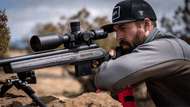Tips for Choosing a Rifle Scope
Posted by Red Hawk Rifles on Feb 26th 2024
You might be looking for your first rifle scope or you might be in the market for another one. The questions still come up of “Which rifle scope is best?” and “Which rifle scope should I choose?” These are our tips for choosing a rifle scope to meet your needs.
The problem is that everyone’s needs are different, so we’re going to go over some tips for choosing your rifle scope.
Scope and Rifle Role
The role your rifle is going to fill is a major factor when it comes to scope selection. We’re going to divide rifle roles into two major categories: general purpose and special purpose.
General purpose
A general purpose rifle is the gun you can use for most things. This means something like a hunting rifle you use for every hunt or a gun you use for both competition and home defense. If the rifle needs to fit multiple roles, your choice of scope has to compromise in order to do everything well but not amazingly.
This type of rifle usually benefits from Low Powered Variable optics, fixed power scopes, or scopes with low to medium magnification.
Special Purpose
Special Purpose rifles are built for a specific role and do it very well. Extreme long range target shooting and long range hunting are examples of hyper specific rifle builds. They have to be able to perform at or above 800 yards and therefore need a large amount of magnification and lens clarity.
This is where the 6-24x scopes or similar offerings are the better options because they are designed with these factors in mind.
First or Second Focal Plane
Which focal plane your scope’s reticle is on is another factor when choosing a scope. Hunters prefer a second focal plane scope because it provides a very consistent sight picture, the only drawback being that the reticle’s measurements only work on max power.
First focal plane scopes have reticles that “change size” under magnification but their measuring tools and other features are always a constant value. This can be challenging if the reticle looks too small at lower magnification. This type of scope is more likely to be found on general purpose rifles that are trying to blend close and long range shooting.
Which focal plane you choose is more down to your personal preference and needs. If you need to be able to range things without using a rangefinder, the first focal plane is going to be a better option. If you just use the center of the cross hair, a second focal plane will be your primary choice.
Scope Magnification
For general use low powered to medium power scopes will be more beneficial in wider circumstances. This might mean a 1-4x, 1-8x, or even a 2-12x scope. They will be able to handle most tasks and may even have better clarity than higher magnification scopes.
But if you are one of those individuals who needs to make those extremely longshots, you will be better off with a 6-24x or a 7-35x scope. It all comes down to the ranges you are expecting to shoot at.
Glass Clarity
The image quality of your scope can matter more than the magnification. You might have a high magnification but the scope itself might make everything seem muted or even hazy. The clarity of the glass is an important factor when you are trying to see things that blend into their environment well (deer, wild pigs, etc.).
It is easier to make a lower powered scope with good glass clarity than it is to make a high powered scope be extremely clear. This is due to the lens thickness that higher magnification requires. Clear glass is a premium you should be willing to pay for if you need better target identification at long range.
Scope Reticle
Reticles are another personal preference driven factor when it comes to scopes. You might like a very simple crosshair with a few holdover marks. Or you may prefer a “Christmas tree” reticle that has wind, drop, and holdover marks through the entire reticle.
Your overall ability to use those features of the reticle are what matter. However, there are two other options you need to consider and those are illuminated and non-illuminated reticles.
Illuminated Reticles
Illuminated reticles are very common and are great for using scopes in low light environments. This usually means that they are battery powered with some options using the ambient light to power the reticle.
How evenly the reticle is illuminated and how often you are willing to swap the battery on it will determine which option you will choose. Having a reticle that can be more easily seen in a variety of lighting situations is very beneficial. This usually offsets the inconvenience of maintenance.
Non-Illuminated Reticles
Non-illuminated reticles are the default reticle of any scope. The only difference is that the illuminated versions can choose when they light up while the non-illuminated never lights up. Some people prefer to shoot these styles of reticles and it cuts down on the chance of your battery dying at a critical point.
If you are going for simplicity, a lack of illumination is the simplest option but you will be hampered by the environment which can make shooting early in the morning or at dusk challenging.
Weight
Oftentimes people want the lightest optic available, especially when they are going to be hiking long distances with their rifle. Weight can be an issue if you start off with a heavier rifle to begin with. Scopes usually add 8 ounces to 24 ounces depending on the design. This is because glass and metal are heavy.
At the end of the day your rifle will probably weigh between 8 and 15 pounds, depending on your setup. If you need every ounce of the weight on that rifle, there is no getting around it. Don’t let a scope's weight deter you from getting it if it has the features you need.
What’s the Best Rifle Scope?
Unfortunately the best scope is the one that works for your situation. Without knowing all of the variables that you may encounter, the best scope option is subjective. As a general rule you will want a durable scope that is clear enough to positively identify what you’re shooting at with a reticle that will help you achieve that more easily.
On top of this an illuminated reticle should probably be included (if you don’t want it illuminated, just turn off the illumination). If you need a general use rifle a 2-12x or 4-16x will be the middle ground for your choices. Anything more specific and you will need a more refined answer.
One of our best selling rifles scopes is by far the Zeiss V4 line. This line offers a good range of magnifications to cover any situation. In our opinion, the glass on the V4 is hands down the best glass you will find in any scope under $1500.








